非谓语动词之分词作状语
- 格式:ppt
- 大小:1.67 MB
- 文档页数:27


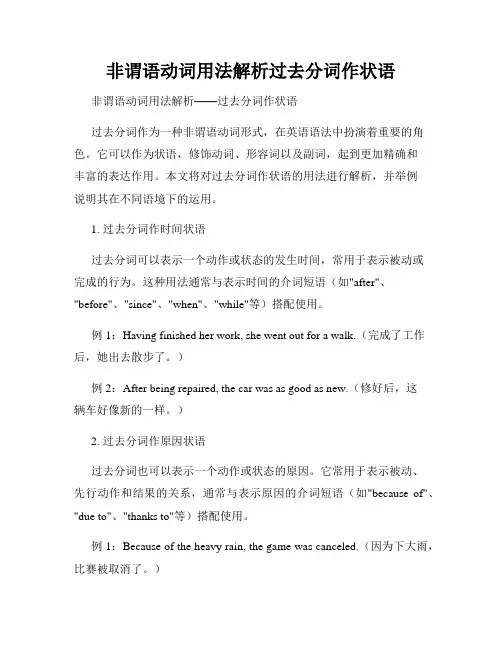
非谓语动词用法解析过去分词作状语非谓语动词用法解析——过去分词作状语过去分词作为一种非谓语动词形式,在英语语法中扮演着重要的角色。
它可以作为状语,修饰动词、形容词以及副词,起到更加精确和丰富的表达作用。
本文将对过去分词作状语的用法进行解析,并举例说明其在不同语境下的运用。
1. 过去分词作时间状语过去分词可以表示一个动作或状态的发生时间,常用于表示被动或完成的行为。
这种用法通常与表示时间的介词短语(如"after"、"before"、"since"、"when"、"while"等)搭配使用。
例1:Having finished her work, she went out for a walk.(完成了工作后,她出去散步了。
)例2:After being repaired, the car was as good as new.(修好后,这辆车好像新的一样。
)2. 过去分词作原因状语过去分词也可以表示一个动作或状态的原因。
它常用于表示被动、先行动作和结果的关系,通常与表示原因的介词短语(如"because of"、"due to"、"thanks to"等)搭配使用。
例1:Because of the heavy rain, the game was canceled.(因为下大雨,比赛被取消了。
)例2:Due to his hard work, he achieved great success.(由于他的努力,他取得了巨大的成功。
)3. 过去分词作方式状语过去分词还可以表示一个动作的方式或方式。
它常与表示方式的介词短语(如"by")或连词(如"as")搭配使用。
例1:He won the race by running faster than others.(他通过比其他人跑得更快赢得了比赛。
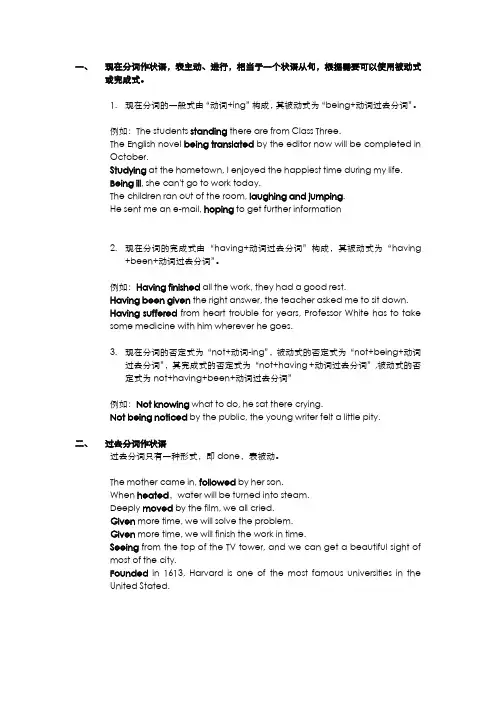
一、现在分词作状语,表主动、进行,相当于一个状语从句,根据需要可以使用被动式或完成式。
1.现在分词的一般式由“动词+ing”构成,其被动式为“being+动词过去分词”。
例如:The students standing there are from Class Three.The English novel being translated by the editor now will be completed inOctober.Studying at the hometown, I enjoyed the happiest time during my life.Being ill, she can't go to work today.The children ran out of the room, laughing and jumping.He sent me an e-mail, hoping to get further information2.现在分词的完成式由“having+动词过去分词”构成,其被动式为“having+been+动词过去分词”。
例如:Having finished all the work, they had a good rest.Having been given the right answer, the teacher asked me to sit down.Having suffered from heart trouble for years, Professor White has to takesome medicine with him wherever he goes.3.现在分词的否定式为“not+动词-ing”,被动式的否定式为“not+being+动词过去分词”,其完成式的否定式为“not+having +动词过去分词”,被动式的否定式为not+having+been+动词过去分词”例如:Not knowing what to do, he sat there crying.Not being noticed by the public, the young writer felt a little pity.二、过去分词作状语过去分词只有一种形式,即done,表被动。
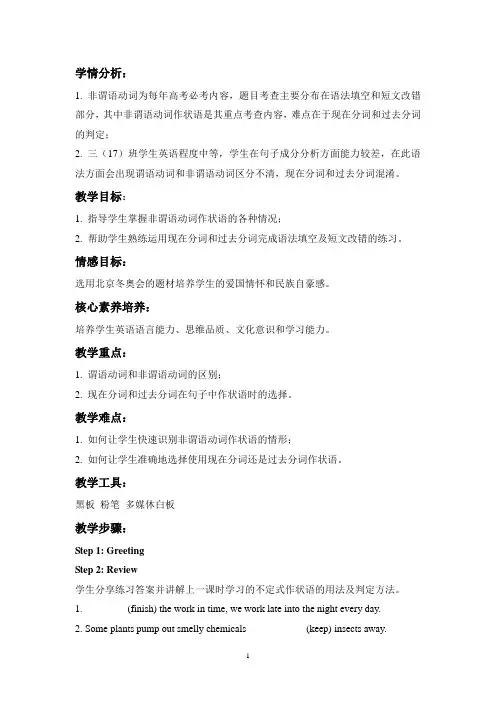
学情分析:1. 非谓语动词为每年高考必考内容,题目考查主要分布在语法填空和短文改错部分,其中非谓语动词作状语是其重点考查内容,难点在于现在分词和过去分词的判定;2. 三(17)班学生英语程度中等,学生在句子成分分析方面能力较差,在此语法方面会出现谓语动词和非谓语动词区分不清,现在分词和过去分词混淆。
教学目标:1. 指导学生掌握非谓语动词作状语的各种情况;2. 帮助学生熟练运用现在分词和过去分词完成语法填空及短文改错的练习。
情感目标:选用北京冬奥会的题材培养学生的爱国情怀和民族自豪感。
核心素养培养:培养学生英语语言能力、思维品质、文化意识和学习能力。
教学重点:1. 谓语动词和非谓语动词的区别;2. 现在分词和过去分词在句子中作状语时的选择。
教学难点:1. 如何让学生快速识别非谓语动词作状语的情形;2. 如何让学生准确地选择使用现在分词还是过去分词作状语。
教学工具:黑板粉笔多媒休白板教学步骤:Step 1: GreetingStep 2: Review学生分享练习答案并讲解上一课时学习的不定式作状语的用法及判定方法。
1. ________ (finish) the work in time, we work late into the night every day.2. Some plants pump out smelly chemicals ___________ (keep) insects away.3. You will never know how happy I was ________ (see) her yesterday.4. As it was getting late we started looking for a hotel, only ___________ (find) that all the hotels were booked.5. (改错)The fans hurried to the airport, only be told the film stars had left.6. (改错)Walking alone in the dark, the boy whistled to keeping up his courage. Step 3: Lead-in视频北京冬奥会场馆介绍,观看完成后小组合作完成对应的语法填空,导入本节课的主要内容,并由学生提出在完成练习的过程中所遇到的问题。

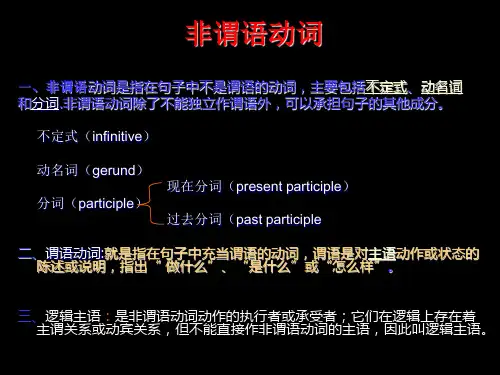
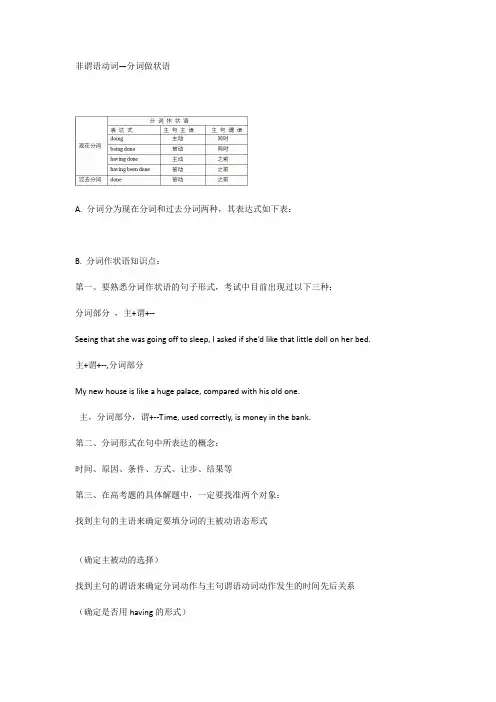
非谓语动词—分词做状语A. 分词分为现在分词和过去分词两种,其表达式如下表:B. 分词作状语知识点:第一、要熟悉分词作状语的句子形式,考试中目前出现过以下三种:分词部分,主+谓+--Seeing that she was going off to sleep, I asked if she’d like that little doll on her bed.主+谓+--,分词部分My new house is like a huge palace, compared with his old one.主,分词部分,谓+--Time, used correctly, is money in the bank.第二、分词形式在句中所表达的概念:时间、原因、条件、方式、让步、结果等第三、在高考题的具体解题中,一定要找准两个对象:找到主句的主语来确定要填分词的主被动语态形式(确定主被动的选择)找到主句的谓语来确定分词动作与主句谓语动词动作发生的时间先后关系(确定是否用having的形式)第四、分词作状语时,若分词表示的动作发生在主句谓语动词动作之前并结束的话,那分词就要用having done、having been done的形式,主动用having done,被动用having been done;否则,就用doing或done的形式,主动用doing被动用done。
注意:being done的用法暂不用考虑!例一、Looking at my classmates' faces, I read the same excitement in their eyes.解析:Looking的动作并不是先发生完再发生read这个动作,因此不用having的形式,故选择looking或looked两种形式,又由于主句主语I与look这个动作是主动关系,所以答案为looking。
翻译成:当我看到同学们的面部表情时,我就看出了他们眼中同样的激动之情。
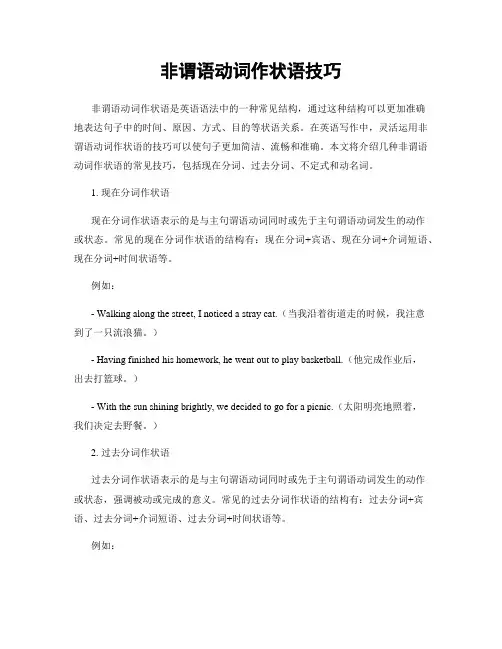
非谓语动词作状语技巧非谓语动词作状语是英语语法中的一种常见结构,通过这种结构可以更加准确地表达句子中的时间、原因、方式、目的等状语关系。
在英语写作中,灵活运用非谓语动词作状语的技巧可以使句子更加简洁、流畅和准确。
本文将介绍几种非谓语动词作状语的常见技巧,包括现在分词、过去分词、不定式和动名词。
1. 现在分词作状语现在分词作状语表示的是与主句谓语动词同时或先于主句谓语动词发生的动作或状态。
常见的现在分词作状语的结构有:现在分词+宾语、现在分词+介词短语、现在分词+时间状语等。
例如:- Walking along the street, I noticed a stray cat.(当我沿着街道走的时候,我注意到了一只流浪猫。
)- Having finished his homework, he went out to play basketball.(他完成作业后,出去打篮球。
)- With the sun shining brightly, we decided to go for a picnic.(太阳明亮地照着,我们决定去野餐。
)2. 过去分词作状语过去分词作状语表示的是与主句谓语动词同时或先于主句谓语动词发生的动作或状态,强调被动或完成的意义。
常见的过去分词作状语的结构有:过去分词+宾语、过去分词+介词短语、过去分词+时间状语等。
例如:- Exhausted from the long journey, she went straight to bed.(因为长途旅行而疲惫不堪,她直接上床睡觉。
)- Having been invited to the party, I couldn't refuse.(因为被邀请参加派对,我不能拒绝。
)- Surprised by the sudden news, they didn't know how to react.(因为突然的消息,他们不知道如何反应。
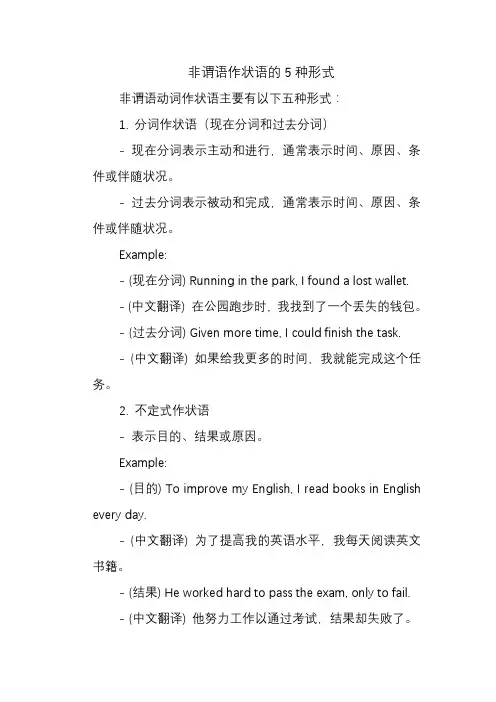
非谓语作状语的5种形式非谓语动词作状语主要有以下五种形式:1. 分词作状语(现在分词和过去分词)- 现在分词表示主动和进行,通常表示时间、原因、条件或伴随状况。
- 过去分词表示被动和完成,通常表示时间、原因、条件或伴随状况。
Example:- (现在分词) Running in the park, I found a lost wallet.- (中文翻译) 在公园跑步时,我找到了一个丢失的钱包。
- (过去分词) Given more time, I could finish the task.- (中文翻译) 如果给我更多的时间,我就能完成这个任务。
2. 不定式作状语- 表示目的、结果或原因。
Example:- (目的) To improve my English, I read books in English every day.- (中文翻译) 为了提高我的英语水平,我每天阅读英文书籍。
- (结果) He worked hard to pass the exam, only to fail.- (中文翻译) 他努力工作以通过考试,结果却失败了。
- (原因) To see her smile is to understand her happiness.- (中文翻译) 看到她的微笑就能理解她的幸福。
3. 句子作状语- 通常是一个完整的句子,用来修饰主句,表示原因、条件、时间等。
Example:- (原因) Because it was raining, we canceled the trip.- (中文翻译) 因为下雨,我们取消了旅行。
- (条件) If it rains, we will stay at home.- (中文翻译) 如果下雨,我们就待在家里。
- (时间) When the bell rings, the class will start.- (中文翻译) 当铃声响起时,课程就开始了。

非谓语状语非谓语动词指的是在句子中不做谓语的动词,主要包括不定式、动名词、现在分词和过去分词。
如果句子中已经有了谓语动词,并且没有连词,那么其他的动词就需要用非谓语形式。
可以做状语的非谓语形式有动词分词、不定式。
非谓语动词做状语有以下几种用法:1.分词做状语分词有现在分词和过去分词,根据动作与主语的关系决定;另外还有各种时态,根据动作发生的时间和顺序决定(doing, having done, done, being done, having been done)。
当主语与非谓语动词为主动关系时,非谓语动词用现在分词形式,如果动作发生在主句谓语之前则用having done的形式。
当主语和非谓语动词为被动关系时,非谓语动词用过去分词形式。
(1)时间状语:Working in the factory,he was an advanced worker.在工厂工作时,他是一名先进工人。
When completed, the road will be open to the public. 这条路在竣工后会正式通车。
(2)方式状语(表示伴随):He sat in the chair reading newspapers. 他坐在椅子上看报。
She came into the office, followed by her assistant. 她走进办公室,身后跟着她的助理。
(3)原因状语:Seeing the cat, the mouse ran off. 见到猫,老鼠就跑了。
Defeated by his desk mate, he felt discouraged. 由于被同桌打败,他感到气馁。
(4)条件状语:You won’t pass the exam playing computer games all day. 这样整天玩电脑游戏你是不会通过考试的。
Given more time, I can pass the exam. 如果多给我点时间,我会通过考试的。
非谓语动词用法精讲分词作状语的用法和常见形式非谓语动词用法精讲:分词作状语的用法和常见形式非谓语动词是指不作谓语,不具备时态和人称变化的动词形式,包括不定式、动名词和分词。
其中,分词作为非谓语动词的一种形式,常常被用作状语来修饰句子的主语、宾语或其他成分。
本文将重点讲解分词作为状语的用法和常见形式。
一、分词作状语的用途分词作为状语可以表示时间、原因、条件、结果、方式等不同的语义关系。
根据这些关系,分词可以用作时间状语、原因状语、条件状语、结果状语和方式状语。
1. 分词作时间状语分词作时间状语时,可以表示动作发生的时间、顺序或同时性等。
常见的分词形式包括现在分词和过去分词。
- Walking along the river, I saw a beautiful sunset.- Having finished my homework, I went out to play.- Having been a teacher for many years, he knows how to handle students.2. 分词作原因状语包括现在分词和过去分词。
- Being tired, she decided to take a nap.- Seen from the top of the mountain, the city looked magnificent.- The car crashed into a tree, causing serious injuries.3. 分词作条件状语分词作条件状语时,可以表示动作发生的条件。
常见的分词形式包括现在分词和过去分词。
- Provided with enough resources, they can finish the project on time.- Weather permitting, we will have a picnic in the park.- Given the circumstances, I had no choice but to accept the offer.4. 分词作结果状语分词作结果状语时,可以表示动作的结果或效果。
高中英语知识点归纳非谓语动词作状语非谓语动词作状语是高中英语的重要知识点之一。
非谓语动词包括不定式、动名词和分词,它们可以在句子中充当状语,用来修饰动词、形容词或副词,起到说明动作、表达原因、目的、结果、条件等作用。
下面是对非谓语动词作状语的归纳总结。
一、不定式作状语不定式作状语可以表示目的、结果、原因、条件等。
常见的结构有:1. 目的状语:She went to the supermarket to buy some vegetables.她去超市买蔬菜。
2. 结果状语:He studied hard to pass the exam.他努力学习以通过考试。
3. 原因状语:He hurried home to avoid the rain.他匆忙回家以避雨。
4. 条件状语:To solve the problem, we need to work together.为了解决这个问题,我们需要共同努力。
二、动名词作状语动名词作状语可以表示目的、结果、原因、时间、方式等。
常见的结构有:1. 目的状语:He practices playing the piano every day to improve his skills.他每天练习弹钢琴以提高技能。
2. 结果状语:She couldn't sleep, feeling worried about the exam.她无法入睡,对考试感到担忧。
3. 原因状语:They raised their voices, shouting for help.他们提高了声音,呼救。
4. 时间状语:Walking along the street, I saw an old friend of mine.走在街上的时候,我碰见了一个老朋友。
5. 方式状语:He solved the math problem by using a different method.他用不同的方法解决了这个数学问题。